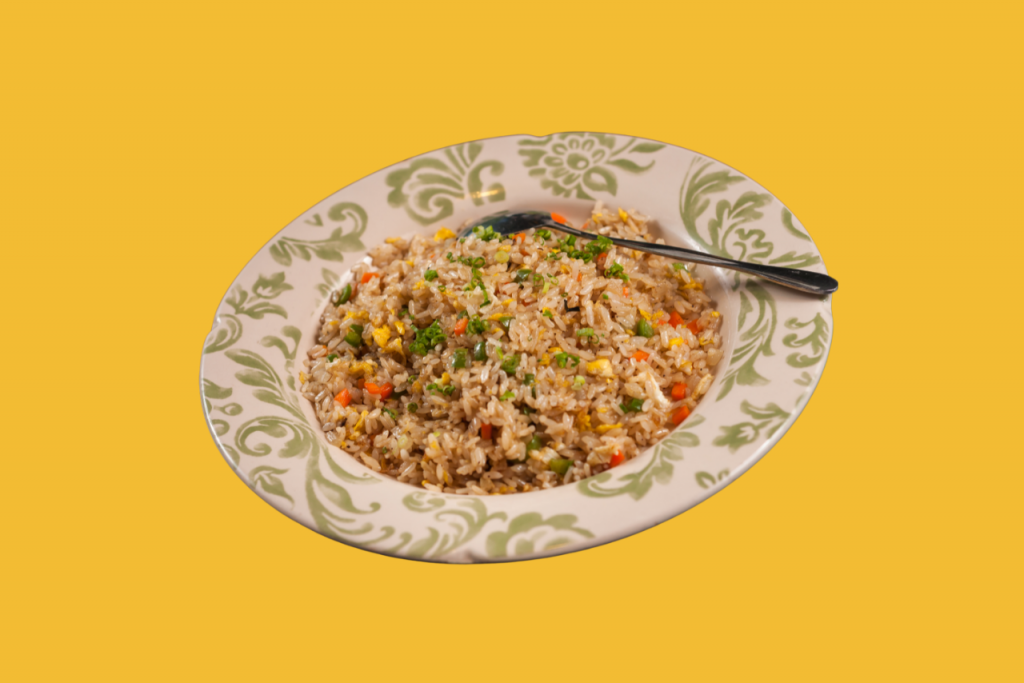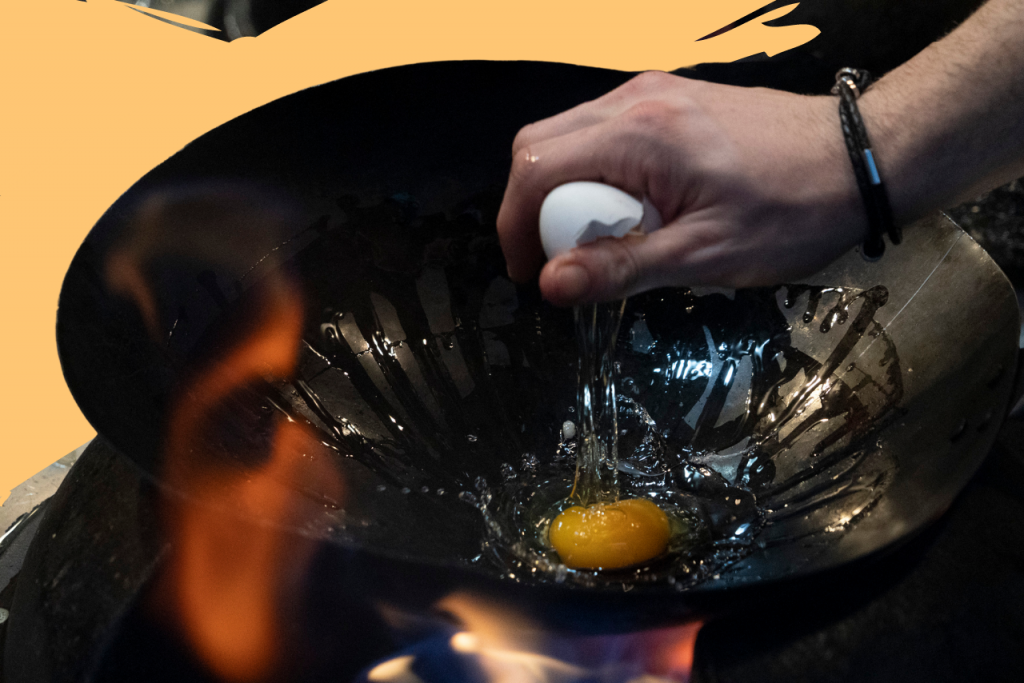Could there be a more quick, comforting, and cost effective dinner than egg fried rice? A way to use up yesterday’s rice and any leftovers you may have in your fridge, as well as being a delicious vehicle for your five-a-day, egg fried rice could well be the ultimate midweek meal.
The perfect way to make fried rice is discussed with fervour in kitchens and on internet forums daily, with everything from the order to add ingredients to the ideal moisture content of the rice up for debate. These preferences often concern the cook’s country of origin and their wants and whims on the day of cooking, and whilst there is no correct way to make egg fried rice, the one below comes out pretty perfectly each and every time.
No longer relegated to a side dish and a delicious midweek meal in its own right, here’s how to make the IDEAL egg fried rice in 5 simple steps.
LEFTOVER RICE OR FRESHLY COOKED?
Most cooks prefer to use leftover rice, for reasons of thrift, sure, but also because rice on the drier side does tend to work better. Rice that’s been in the fridge overnight will have had the chance to dry out a little, with some of its moisture evaporating, and this avoids a stodgy finish to the dish.
Do remember to take the rice out of the fridge half an hour or so before you intend to use it; fridge cold rice tends to be clumpy when fried, and you don’t want that. Scrupulous cooks gently break up the grains with their hands prior to frying them, too.
Alternatively, some cooks choose to use freshly cooked rice. If you’re cooking the rice specifically for your dinner, use a little less water than you normally would. When it’s done, spread your cooked rice out on a baking tray for 15 minutes or so before frying, to allow some water to evaporate and the rice to cool slightly, which leads to a more even finish on your fried rice.
Regardless of the method you choose, you’ll want roughly 1 cup of rice per person. Generally speaking, you shouldn’t attempt to make more than one portion, two at a push, at a time; crowding your wok rather defeats the point of using one. We’re not steaming our rice, after all.
We prefer to use jasmine rice, for its unsurpassable fragrance, its medium to long grain achieving the ideal fluffy texture.
*It is considered safe to eat leftover rice, as long as it didn’t remain at room temperature for long after cooking, was cooled and stored correctly, and is thoroughly reheated until steaming hot throughout. You can read more from the NHS on reheating rice here*

NO WOK, NO OIL EGG FRIED RICE
For those keen to avoid using oil to make their egg fried rice, or for those situations when there’s no hobs handy (such as in the office kitchen), a third way exists; microwave egg fried rice.
Ready to eat in just a couple of minutes, this no wok egg fried rice takes just 3 steps to complete. Firstly, simply microwave a packet of rice according to the instructions. Then, microwave two beaten eggs (in a microwave proof bowl, covered in plastic wrap with a few holes poked in the top) on medium to high heat for 90 seconds. Finally, microwave a handful of frozen vegetables of your choosing on high heat for another 90 seconds. Mix the three components together and season to your liking, using sriracha, soy sauce and oyster sauce.
Read more about this super quick method for some fantastic recipe ideas.
STEP 1: GET YOUR WOK MEDIUM HOT & OIL PERFUMED
Back to the IDEAL egg fried rice….
Ideally, you’ll want to use a wok to cook egg fried rice, regardless of whether you’ve got a gas hob or electric stove top. The former heat source is preferable, but it’s the shape of the wok that matters here, too.
Using a wok enables you to apply a more even coating of oil to the pan, allowing you to gently swill the oil around, coating the sides and preventing the rice catching.
What’s more, the shape of a wok helps with heat control; you can push elements that are cooked up the sides of your pan, focusing new ingredients on the centre, where the heat is stronger. If you don’t have a wok, use a wide based, high sided frying pan.
Anyway, enough talk; heat your pan to a medium high heat, then add two tablespoons of vegetable oil.
Crush a clove of garlic under your palm and add it to the oil. When the garlic clove is close to browning, hoick it back out with a slotted spoon and discard. This process perfumes the oil, adding a delicate fragrance to each and every grain of rice.

STEP 2: ADD YOUR EGG & SCRAMBLE
With oil perfumed invitingly, turn the heat up to high. Crack an egg into the oil and allow the whites to set for 15 seconds or so. Then, with a fork or spatula and working outwards from the yolk, scramble the egg until almost cooked.
Push your scrambled egg mixture up the sides of your pan, readying the oil for your vegetables. Alternatively, you could remove the cooked egg entirely, ready to mix back into your rice later. The choice is yours.
Read: How to cook the IDEAL egg, 5 ways
STEP 3: ADD YOUR VEGETABLES
Some versions of egg fried rice will keep things ultra simple, but we’re keen to bulk ours out to ensure it’s a nourishing midweek supper. Accordingly, it’s time to add some vegetables.
You can use a selection of what’s kicking about in your fridge, diced fairly finely. We particularly like courgette, carrot, cabbage, peas, sliced onion and sweetcorn to provide the body, with sliced spring onions and chillies added later, when the rice is cooked and the pan off the heat. Alternatively, frozen varieties of those vegetables are brilliant for speeding up the prep process further, but you’ll need to cook them for a little longer. Consider adding kimchi for a Korean twist.
So, skip this step entirely if you’re after an egg fried rice that sings with simplicity, or, when the pan has returned to a high heat, add a good handful of your chosen vegetables to the pan, cooking until almost done, which should take just a few minutes.

STEP 4: ADD YOUR RICE
Next, move your vegetables (if you added them) up the side of your pan to join the egg (or, again, remove them entirely if you’re being diligent).
Then, when the pan has returned to a high heat, add your rice, which you’ve diligently broken up by hand first. Doing this ensures that your performed oil will lightly coat every grain. It’s important that your wok remains at a high heat throughout the cooking, to avoid that dreaded claggy texture that a lower temperature leads to.
Cook the rice for three or four minutes, stirring or flipping in a cheffy fashion regularly, until it’s steaming hot throughout.
STEP 5: SEASON & SERVE
While the rice is cooking, prepare a seasoning mix of soy and oyster sauce, white pepper and sugar (just a little, oyster sauce is already pretty sweet), tasting to check the balance is right. Fried rice shouldn’t be highly seasoned – it tends to work best as a gentle dish – but you do you. We would use 2 tablespoons of light soy sauce to a teaspoon of oyster sauce per 1 cup of rice. Just a pinch of both sugar and white pepper will do.
Then, once again, push your rice to the side of the pan slightly to make space for your seasoning mixture. Add it to the pan and allow it to caramelise slightly. Finally, mix everything together; your seasoning sauce with the rice, egg and vegetables. Add a few sliced spring onions, perhaps a sliced bird’s eye chilli, and a few leaves of coriander, and serve.





